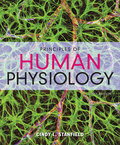
Concept explainers
Introduction:
Oxidation is a reaction in which addition of oxygen happens or release of electron takes place of when the release of hydrogen occurs. The oxidation of glucose in the cells occurs along with the formation of ATP (adenosine triphosphate), they are known as the energy currency of the cells. Carbon dioxide and oxygen are also released. When a molecule of glucose undergoes oxidation in the cell, the oxygen molecule reacts with the hydrogen molecules and form water molecules. This entire reaction is named
Answer to Problem 1E
Correct answer:
Option (b) is the correct answer. When glucose compound undergoes oxidation in the cells, oxygen reacts with hydrogen ion and forms water.
Explanation of Solution
Explanation/justification for the correct answer:
Here in this reaction, glucose molecule is oxidized to release carbon dioxide and oxygen is reduced to form water by combining with the hydrogen ions.
This entire reaction can be given by the equation:
Thus, option (b) is the correct answer i.e., oxygen reacts with a hydrogen ion and form water by getting reduced.
Explanation for the incorrect answer:
Option (a) is incorrect since oxygen atoms gain electrons from the hydrogen and not carbon, so it produces water and not carbon dioxide.
Option (c) is also not correct as finally the electron is accepted by oxygen. Oxygen receives this electron directly from hydrogen and forms water molecules.
Option (d) is also incorrect since the formation of ATP is different than this reaction which doesn’t require oxygen atom for that reaction.
Option (e) is not true as the formation of acetate from acetyl CoA involves citric acid cycle or Krebs cycle which doesn’t include oxidation of glucose.
We can hence conclude that option (b) is the correct answer, that is, oxygen reacts with a hydrogen ion and form water by getting reduced.
Want to see more full solutions like this?
Chapter 3 Solutions
EBK PRINCIPLES OF HUMAN PHYSIOLOGY
- please fill in the empty sports, thank you!arrow_forwardIn one paragraph show how atoms and they're structure are related to the structure of dna and proteins. Talk about what atoms are. what they're made of, why chemical bonding is important to DNA?arrow_forwardWhat are the structure and properties of atoms and chemical bonds (especially how they relate to DNA and proteins).arrow_forward
- The Sentinel Cell: Nature’s Answer to Cancer?arrow_forwardMolecular Biology Question You are working to characterize a novel protein in mice. Analysis shows that high levels of the primary transcript that codes for this protein are found in tissue from the brain, muscle, liver, and pancreas. However, an antibody that recognizes the C-terminal portion of the protein indicates that the protein is present in brain, muscle, and liver, but not in the pancreas. What is the most likely explanation for this result?arrow_forwardMolecular Biology Explain/discuss how “slow stop” and “quick/fast stop” mutants wereused to identify different protein involved in DNA replication in E. coli.arrow_forward
- Molecular Biology Question A gene that codes for a protein was removed from a eukaryotic cell and inserted into a prokaryotic cell. Although the gene was successfully transcribed and translated, it produced a different protein than it produced in the eukaryotic cell. What is the most likely explanation?arrow_forwardMolecular Biology LIST three characteristics of origins of replicationarrow_forwardMolecular Biology Question Please help. Thank you For E coli DNA polymerase III, give the structure and function of the b-clamp sub-complex. Describe how the structure of this sub-complex is important for it’s function.arrow_forward
 Human Anatomy & Physiology (11th Edition)BiologyISBN:9780134580999Author:Elaine N. Marieb, Katja N. HoehnPublisher:PEARSON
Human Anatomy & Physiology (11th Edition)BiologyISBN:9780134580999Author:Elaine N. Marieb, Katja N. HoehnPublisher:PEARSON Biology 2eBiologyISBN:9781947172517Author:Matthew Douglas, Jung Choi, Mary Ann ClarkPublisher:OpenStax
Biology 2eBiologyISBN:9781947172517Author:Matthew Douglas, Jung Choi, Mary Ann ClarkPublisher:OpenStax Anatomy & PhysiologyBiologyISBN:9781259398629Author:McKinley, Michael P., O'loughlin, Valerie Dean, Bidle, Theresa StouterPublisher:Mcgraw Hill Education,
Anatomy & PhysiologyBiologyISBN:9781259398629Author:McKinley, Michael P., O'loughlin, Valerie Dean, Bidle, Theresa StouterPublisher:Mcgraw Hill Education, Molecular Biology of the Cell (Sixth Edition)BiologyISBN:9780815344322Author:Bruce Alberts, Alexander D. Johnson, Julian Lewis, David Morgan, Martin Raff, Keith Roberts, Peter WalterPublisher:W. W. Norton & Company
Molecular Biology of the Cell (Sixth Edition)BiologyISBN:9780815344322Author:Bruce Alberts, Alexander D. Johnson, Julian Lewis, David Morgan, Martin Raff, Keith Roberts, Peter WalterPublisher:W. W. Norton & Company Laboratory Manual For Human Anatomy & PhysiologyBiologyISBN:9781260159363Author:Martin, Terry R., Prentice-craver, CynthiaPublisher:McGraw-Hill Publishing Co.
Laboratory Manual For Human Anatomy & PhysiologyBiologyISBN:9781260159363Author:Martin, Terry R., Prentice-craver, CynthiaPublisher:McGraw-Hill Publishing Co. Inquiry Into Life (16th Edition)BiologyISBN:9781260231700Author:Sylvia S. Mader, Michael WindelspechtPublisher:McGraw Hill Education
Inquiry Into Life (16th Edition)BiologyISBN:9781260231700Author:Sylvia S. Mader, Michael WindelspechtPublisher:McGraw Hill Education





